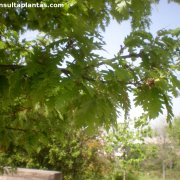Care of the tree Quercus cerris or Turkey oak |
|
The genus Quercus, family Fagaceae, comprises 500 species of trees and shrubs native to Europe, North America, Asia and South America. Some species are: Quercus cerris, Quercus ilex, Quercus suber, Quercus coccifera, Quercus canariensis, Quercus alba, Quercus garryana, Quercus robur. Common names: Austrian oak, Turkey oak. This species is native to south-eastern Europe and Asia Minor. They are fast growing deciduous trees with a pyramidal crown that reach 25 meters (82 feet) in height. The attractive lobed leaves have serrated margins and are deep green in color. They bloom in spring but the flowers are of no ornamental interest. The fruits are acorns. Turkey oak is used in small and medium gardens as isolated specimens to provide shade. Quercus cerris prefers a shady or semi-shaded exposure in hot climates (Mediterranean climate); in colder climates they grow well in full sun. It resists frost down to -12 ºC (10.4 ºF). Austrian oak grows in any type of soil but prefers it to be well drained and deep. Water moderately throughout the year waiting for the substrate to dry. Fertilize with compost in early spring. Turkey oak can be lightly pruned in late winter. Quercus cerris does not usually present serious pest and disease problems. Austrian oak is propagated from seeds sown in fall or late summer. |
Images of the tree Quercus cerris or Turkey oak |
Find plants
Quercus cerris or Turkey oak | Care and Growing
© 2025 FavThemes


